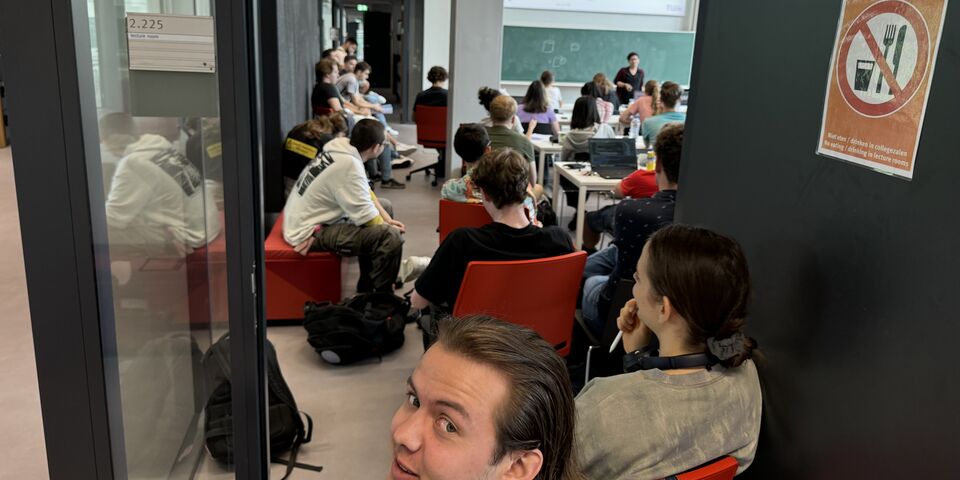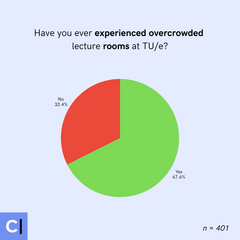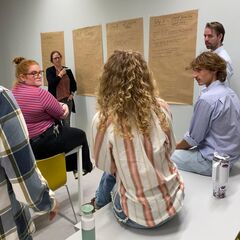Lecture hall shortage: from evening classes to more online
A ninth and tenth hour, more lectures held off-campus, or additional classes online — these are all potential solutions to the severe shortage of lecture halls on campus. A new working group has been consulting students and staff to develop a realistic plan to tackle the issue.
Each year, the number of first-year students at TU/e continues to rise, and with Project Beethoven on the horizon, many additional master’s students are expected as well. However, the university faces a major problem: the available space on campus is not expanding at the same pace. As a result, lecturers often have to switch to online teaching or make do with overcrowded rooms where students are forced to sit on the stairs or bring in extra chairs from the hallway (see photo above).
For years, the university’s Educational Schedulers -who are responsible for scheduling all educational spaces- have been warning about this issue, and they are now sounding the alarm: something has to change. “The TU/e has a “space problem” — and solving it will require all hands on deck, creativity, flexibility, and, at times, some difficult choices,” an internal message reads.
Community feedback
Cursor asked its Instagram followers about their experiences with crowded lecture halls. Of the 401 respondents, a clear majority (68 percent) said they had attended a lecture in an overcrowded room at least once. The remaining 32 percent said they had never encountered this problem.
Future-proof Scheduling
In the past, schedulers managed to get by with temporary fixes and a good dose of creativity, but that is no longer sufficient. “At some point it is just too much, even for us to work our magic,” says Britt Verstappen, Educational Scheduler at Industrial Engineering & Innovation Sciences.
In the long term, the campus will gradually expand. In 2027, new teaching spaces will open in Building S3 (across from Terra), construction of a new lab building will also begin that year, and early in 2028 the renovated Gemini South building is expected to be completed. However, that extra space is still years away, while the shortage is already a pressing issue.
To address this, the Future-proof Scheduling project was launched earlier this year. “The aim of this project is to find both short-term solutions for the 2025-2026 academic year and long-term strategies to optimize space and timetable use,” reads a statement in SharePoint.
Possible Solutions
A first set of short-term solutions has now been shared internally. “Nothing has been decided yet, but the framework is clear,” says Elmer Sachteleben, manager of the future Scheduling Chain, which will serve as a link between faculties and support teams regarding timetabling.
Among the proposed options are using a ninth and tenth teaching slot — these so-called evening hours would take place between 17:30 and 19:15. More teaching off-campus, such as in the Vector building (just outside the campus, opposite the sports center) or in rented classrooms at Fontys. More hybrid education — online lectures are already common university-wide, but increasing space pressure means it must be examined whether more teaching can be offered partly or fully online. Reorganizing course components — faculties may rearrange the order of course elements, such as lectures or study sessions, to prevent scheduling conflicts. Such changes always require consultation with the program director and the Education and Student Affairs manager.
A Critical Perspective
The proposed measures are based on input and feedback from all layers of the university community. During several sessions, the Future-proof Scheduling working group spoke with deans, students, lecturers, schedulers, study advisors — everyone affected in some way by the current space problem.
These sessions were meant to build mutual understanding, generate new ideas, and critically reflect on existing proposals. What are their pros and cons? For instance, Industrial Design student David Vroegindeweij pointed out that evening slots can only work if there are proper dining options available. “Good food needs to be available on campus for dinner if there are classes after 5:30 PM.” Classes held off-campus also require some thought. Students need extra time to move between locations. Should this responsibility fall on them, or should the time between teaching blocks be extended?
All these questions and more are now being carefully studied by the Future-proof Scheduling working and steering group. Whether and when new scheduling measures will actually be implemented remains to be seen. Decisions will follow after simulations reveal which solutions truly contribute to a future-proof timetable at TU/e. According to Sachteleben, the outcome will be communicated clearly once available:
“In the spirit of transparency, we will continue to keep the community informed. Our final report will include our findings, proposed solutions, and next steps.”
This article was translated using AI-assisted tools and reviewed by an editor.




Discussion